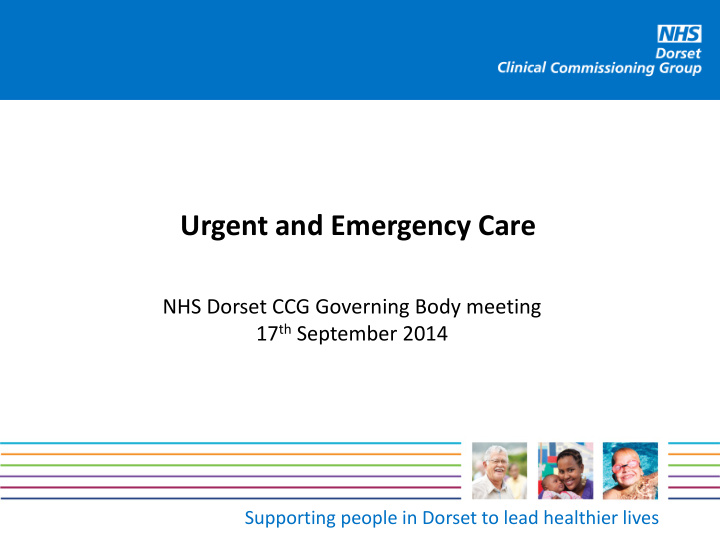



Urgent and Emergency Care NHS Dorset CCG Governing Body meeting 17 th September 2014 Supporting people in Dorset to lead healthier lives
What we know… 111 Service 12% increase in calls received and triaged by 111 services • Recommendations to attend A&E are now 30% (54)above 13/14 monthly • averages with week ending 20/07. Calls answered within 60 seconds target has been missed on for 4 • consecutive weeks from week ending 13/07 to 03/08 corresponding with week on week above average call volumes. Supporting people in Dorset to lead healthier lives
What we know… Ambulance Service Hear & Treat outcomes have increased by 24% with total calls up 6% • See & Convey has increased by 8% resulting in on average an extra 426 • conveyances per month (52% of all attendances) Red 1 performance above Target at 84.5% for Jun-14 for Dorset CCG • patients. 75% for SWASFT overall Supporting people in Dorset to lead healthier lives
What we know… Emergency Department Attendances have continued to increase at all 3 acute providers • PHT ↑ 11%, RBH ↑ 9%, DCH ↑ 5 % Self-referrals continue to rise especially at PHT & RBH with average • monthly increase of 9.9% (281 attends) at PHT and 8.3% (276 attends) at RBH The increase in ED attendances is largely seen in the Out of Hours period • at all 3 acutes but PHT also experiencing an In Hours increase (up 6%. 125 per month) • Increase in MIU attendances now 10% above 2013/14 levels Emergency admissions up across all providers but greatest in RBH • Supporting people in Dorset to lead healthier lives
What we know… Primary care In hours increases seen in all areas – telephone, GP appointments, nurse • appointments and home visits • Out of hours service increases seen in calls, urgent care centre attendances and home visits. • Complexity of patients increasing Supporting people in Dorset to lead healthier lives
What we know… King’s Fund/Oak Group review indicated: • Higher emergency admission rates than average High zero length of stay rates • • Lower rates of ED attendance Complex out of hospital picture • Supporting people in Dorset to lead healthier lives
Ambulance Service Supporting people in Dorset to lead healthier lives
Emergency Department (A&E) Supporting people in Dorset to lead healthier lives
Overview • Increase in activity across all sectors Increase in ‘front door’ demand unexplained • • Greatest pressures seen out of hours, particularly weekends Pressures on the system unsustainable • Urgent care ‘summit’ held on 29 th August 2014 • Supporting people in Dorset to lead healthier lives
Current actions • Assessment of plans against the ‘Acute and emergency care: prescribing the remedy’ paper Emergency Care Intensive Support Team (ECIST) supporting ‘front door’ • analysis and development of the urgent care dashboard • Establishing sector based task groups • Operational Resilience and Capacity Planning Transition of Urgent Care Board to System Resilience Group • Anticipatory care plans and special messages • Over 75s plans • Supporting people in Dorset to lead healthier lives
‘Summit’ actions • Audit at ED ‘why are you attending?’ • Improve communications between SWAST and acutes – availability of consultants that ECPs/paramedics can call Review hospital transfers – high between RCH and PGH • • Reduce the number of admissions from nursing homes • Promote use of MIUs – look at opening hours Hold sector based summits with primary care • Promote use of SPOA – expand to include social care and voluntary sector • Reduce batching of ambulances – smooth the flow • Supporting people in Dorset to lead healthier lives
Summary • Front end activity up (including primary care) • Demographics haven’t changed • Need to consider – here and now, longer term strategy Supporting people in Dorset to lead healthier lives
Recommend
More recommend